
eBook - ePub
Drainage Details
L. Woolley
This is a test
Partager le livre
- 104 pages
- English
- ePUB (adapté aux mobiles)
- Disponible sur iOS et Android
eBook - ePub
Drainage Details
L. Woolley
Détails du livre
Aperçu du livre
Table des matières
Citations
À propos de ce livre
A unique set of 45 information sheets giving complete details of all forms of drainage work for the builder and surveyor.
Foire aux questions
Comment puis-je résilier mon abonnement ?
Il vous suffit de vous rendre dans la section compte dans paramètres et de cliquer sur « Résilier l’abonnement ». C’est aussi simple que cela ! Une fois que vous aurez résilié votre abonnement, il restera actif pour le reste de la période pour laquelle vous avez payé. Découvrez-en plus ici.
Puis-je / comment puis-je télécharger des livres ?
Pour le moment, tous nos livres en format ePub adaptés aux mobiles peuvent être téléchargés via l’application. La plupart de nos PDF sont également disponibles en téléchargement et les autres seront téléchargeables très prochainement. Découvrez-en plus ici.
Quelle est la différence entre les formules tarifaires ?
Les deux abonnements vous donnent un accès complet à la bibliothèque et à toutes les fonctionnalités de Perlego. Les seules différences sont les tarifs ainsi que la période d’abonnement : avec l’abonnement annuel, vous économiserez environ 30 % par rapport à 12 mois d’abonnement mensuel.
Qu’est-ce que Perlego ?
Nous sommes un service d’abonnement à des ouvrages universitaires en ligne, où vous pouvez accéder à toute une bibliothèque pour un prix inférieur à celui d’un seul livre par mois. Avec plus d’un million de livres sur plus de 1 000 sujets, nous avons ce qu’il vous faut ! Découvrez-en plus ici.
Prenez-vous en charge la synthèse vocale ?
Recherchez le symbole Écouter sur votre prochain livre pour voir si vous pouvez l’écouter. L’outil Écouter lit le texte à haute voix pour vous, en surlignant le passage qui est en cours de lecture. Vous pouvez le mettre sur pause, l’accélérer ou le ralentir. Découvrez-en plus ici.
Est-ce que Drainage Details est un PDF/ePUB en ligne ?
Oui, vous pouvez accéder à Drainage Details par L. Woolley en format PDF et/ou ePUB ainsi qu’à d’autres livres populaires dans Architektur et Architektur Methoden & Materialien. Nous disposons de plus d’un million d’ouvrages à découvrir dans notre catalogue.
Informations
Town Drainage Schemes
CI/SfB(52)
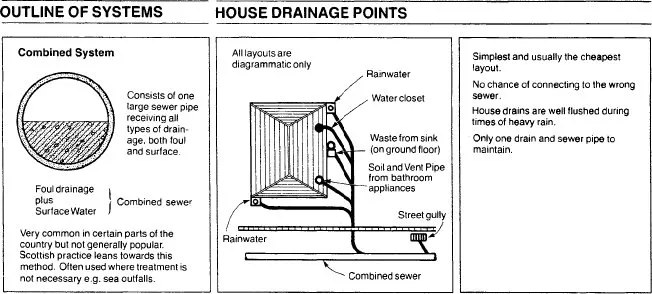

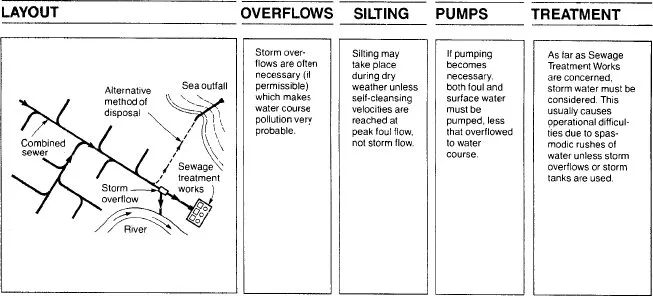
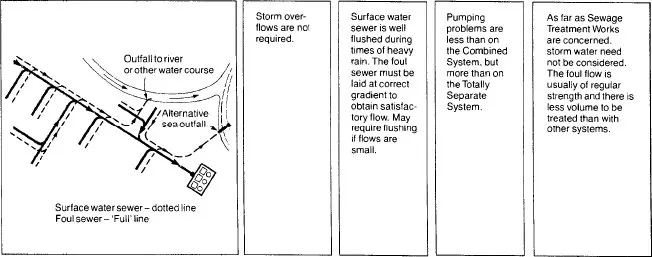
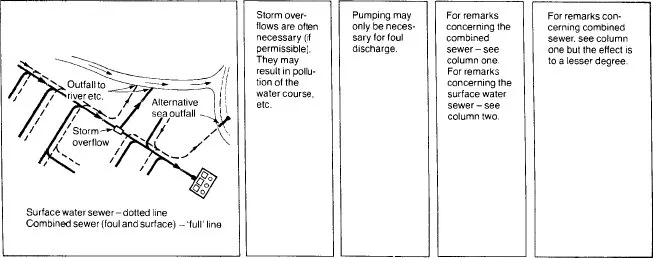
Aim and Design Considerations
CI/SfB(52)
Aim
The aim is to provide a system of self cleansing pipework for -
- the conveyance of foul waste and surface water.
- Speedily and efficiently to the sewer or other outfall,
- Without risk of nuisance or danger to health.
Design Considerations

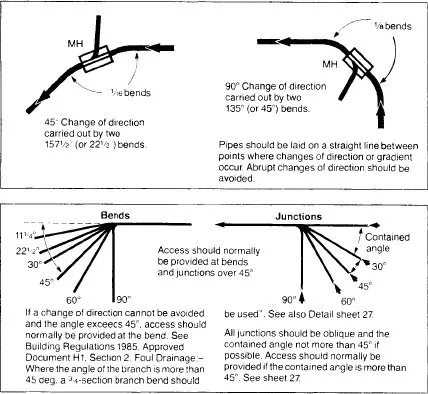

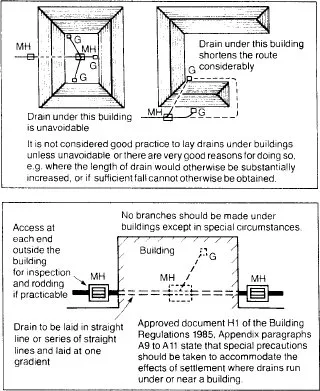
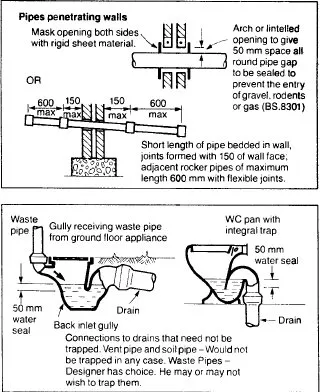
See Approved Document H1, table 2, of the Building Regulations 1985 for minimum trap sizes and seal depths.
Appliance | Diaof Trap mm | Depth of seal mm |
Washbasin, bidet | 32 | 75 |
Sink, bath, I shower, food waste disposal unit, urinal bowl | 40 | 75 |
WC Pan | 75(min) | 50 |
All points of discharge into the system should be fitted with a water seal (trap) to prevent foul air from the system entering into the building underworking.
The distances between access points depend on the types of access used but should not be more than shown in Table 10 of Document H1 of the Building Regulations 1985 for drains up to and including 300 mm.
Definitions
- Surface water. The run-off natural water from ground surface including paved areas, roofs and unpaved lands.
- Waste water. Water not contaminated by soil water or trade effluent can be taken as the discharge from lavatory basins, baths, sinks and similar appliances.
- Soil water. The discharge from a soil appliance such as water closet, urinal receptacle, bed pan washer, slop sink, etc.
- Foul drain. A drain normally designed to take the discharge of both soil and waste water (may also receive trade effluent).
- Waste drain. To receive waste water as distinct from soil and trade effluent.
- Surface water drain. To receive surface water exclusively.
- Inspection chamber. Chamber constructed on a drain so as to provide access thereto for inspection and cleansing (often called "manhole").
Schemes for Town Houses
CI/SfB(52)
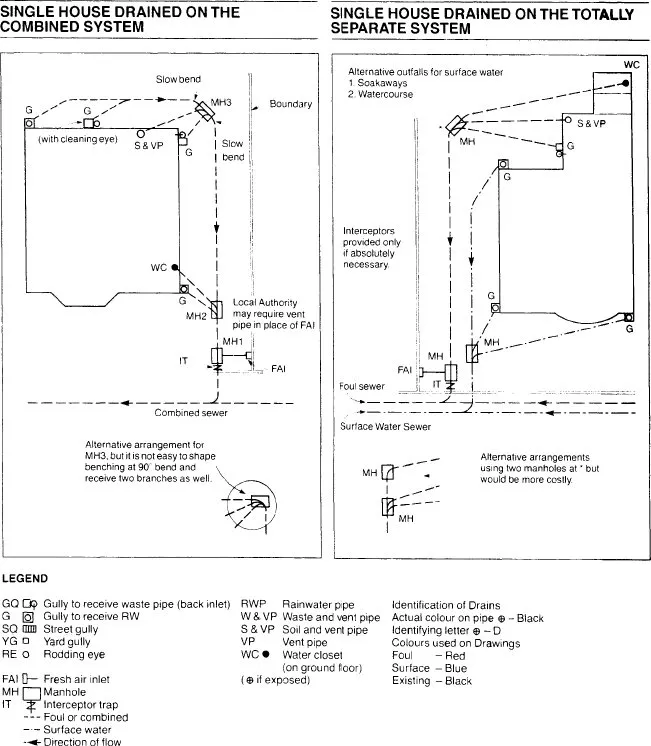
Group of Houses Drained on the Partially Separate System
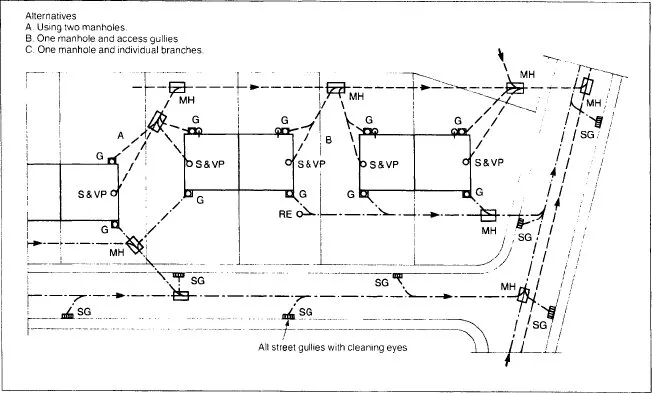
Group of Houses Drained on the Combined System
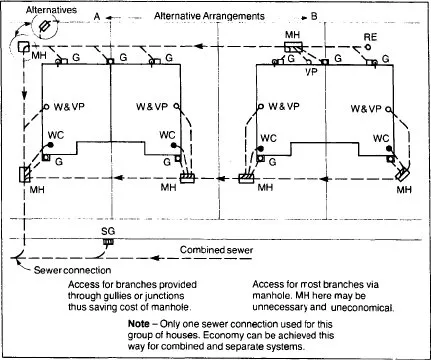
Terraced House

Schemes for Country Houses
CI/SfB(52)
Septic Tanks
In recent years the prefabricated grp septic tanks has tended to supersede the conventional brick or concrete ring units -offering simplicity of installation and cost benefits.
The Septic tank is still a common method of disposing sewage and waste water from single properties and small communities. It provides an environment where gross solids may settle out and where this stored organic matter may undergo anaerobic decomposition. The partially treated liquor then flows to a network of sub-surface irrigation drains to be discharged into the land.
The efficiency of the tank system relies on the suitability of the sub-soil to accept the volume of liquor without causing pollution. Where the sub-soil has a high clay content or similar non-absorbent material, or where there is a high level of ground water, septic tanks will not operate effectively.
Percolation tests will determine the suitability of a particular site for sub-surface irrigation - and details of these tests are set out in BSCP 6297:1983.
Klargester Environmental Engineering makes Septic Tanks in accordance with the Code of Practice, providing a daily flow allowance of at least 180 litres per person on the system, plus a further 2000 litres. Settled sludge is required to be removed from the tank once every year.
Problems experienced with septic tank installations can often be related to the failure to consider either the site ground conditions (soil porosity, high water table) or the requirement for regular de-sludging.
The design feature of the Klargester unit is to prevent gross solids being flushed through the system. This is achieved by means of a series of baffles within the tank creating an upward flow of effiuent through individual stages prior to discharge. Where the ground adjacent to the tank is unsuitable for sub-surface irrigation, a simple pumpset incorporating a prefabricated grp sump may be used to pump the effluent to a remote area where the ground is more suitable.
Care should be taken to instal the tank in accordance with the manufacturer‘s instructions.
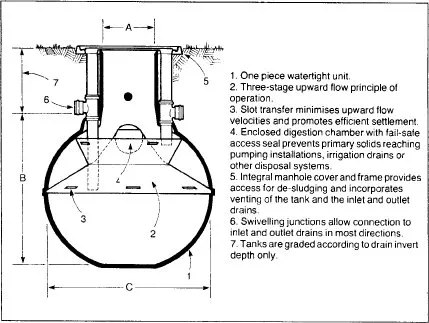

Cesspools
With certain drainage problems, septic tanks may not provide the answer - but the use of a cesspool might. By design, a cesspool is a watertight construction for storing sewage; and difficulties in obtaining a watertight construction for storing sewage have now been generally overcome by using prefabricated glass fibre tanks, which also make installation simpler.
Its physical size can make the installation of a cesspool of the minimum recommended capacity of 18,000 litres a costly business. But, one of the biggest disadvantages could be the recurring emptying costs. An average four-person family could fill the tank in between five and eight we...